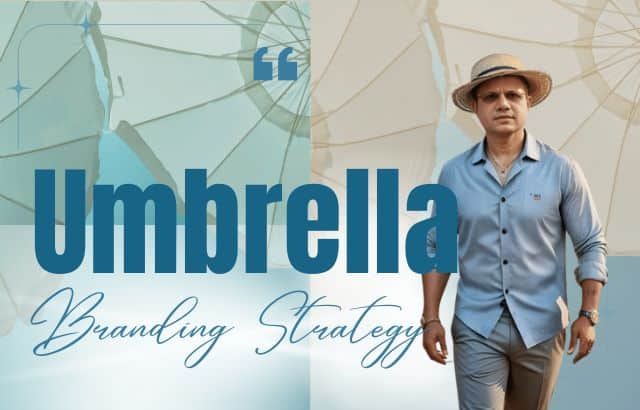In today’s competitive marketplace, brands are constantly searching for strategies that can drive growth, enhance consumer loyalty, and expand their market presence. One such strategy that many successful companies leverage is umbrella branding.
But what is umbrella branding? How does it work, and why is it considered an essential business strategy? In this blog, we will break down the concept of umbrella branding and explore its advantages and potential risks for businesses.
Table of Contents
What Is Umbrella Branding?
Umbrella branding, also known as a family brand strategy, is when a company uses the same brand name or identity for multiple products or product lines. Instead of creating a separate brand for each product, a company ties all products to a single, overarching brand. This can include everything from different product categories to variations of a particular product.
Think of it like a big umbrella, where the company’s main brand serves as the “umbrella” that covers a variety of sub-brands, each falling under the same umbrella but serving different needs.
Examples of Umbrella Branding in Action:
- Apple – From iPhones, iPads, and MacBooks to Apple Music, Apple has created a powerful brand identity that spans multiple categories of tech products and services under one umbrella.
- Virgin Group – The Virgin brand extends across diverse industries such as travel (Virgin Atlantic), music (Virgin Records), health (Virgin Active), and telecommunications (Virgin Mobile). All of these products and services share the same core brand values of innovation and excitement.
- Coca-Cola – Coca-Cola is an umbrella brand for a wide variety of drinks such as Diet Coke, Coca-Cola Zero, Sprite, and Fanta. Each sub-product is marketed under the Coca-Cola umbrella, capitalizing on the brand’s reputation and trustworthiness.
Why Use Umbrella Branding?
Umbrella branding offers several compelling advantages, especially for large corporations looking to expand their reach while maintaining consistency.
1. Cost Efficiency:
Launching a new product under an established umbrella brand is more cost-effective than building a completely new brand identity from scratch. Marketing efforts, such as advertising campaigns, can be shared across different products, allowing the company to save on costs.
2. Instant Brand Recognition:
Consumers already trust and recognize the umbrella brand. When you launch a new product under an established umbrella, that trust and recognition can quickly transfer to the new product, which helps it gain traction in the market faster.
3. Cross-Selling Opportunities:
Because all products are tied to a single brand, there are increased opportunities for cross-selling. For instance, a customer who buys a Coca-Cola drink may be more likely to try a new product under the same brand, like Sprite or Diet Coke.
4. Brand Loyalty and Emotional Connection:
Customers who are loyal to the umbrella brand may be more willing to try other products under the same brand, driven by the positive emotions they associate with it. Apple, for example, has a dedicated fanbase that trusts the brand’s consistent quality and design across all its products.
Risks of Umbrella Branding
While umbrella branding can be highly effective, it’s not without its potential downsides. Businesses should also be aware of these risks:
1. Brand Dilution:
If the umbrella brand starts to cover too many product lines, especially those that are very different from the original offering, it may dilute the brand’s value. For instance, if a luxury brand suddenly starts selling budget products under the same name, it may confuse or alienate loyal customers.
2. Negative Spillover:
If one product under the umbrella brand fails or faces a scandal, it can negatively affect all the other products under that umbrella. For example, if a particular Nike sneaker is found to have a manufacturing defect, it could hurt the brand’s reputation across all its other products.
3. Limited Brand Flexibility:
With an umbrella brand, you are somewhat tied to the core values and image that the umbrella brand represents. This can make it more difficult to introduce radically different or niche products that might not align with the parent brand’s identity.
Roles of a Business Strategist in Umbrella Branding
The role of a strategist, especially someone like Hirav Shah, a renowned business strategist behind many globally successful brands, is critical in implementing umbrella branding. Shah’s expertise lies in crafting strategies that ensure brand consistency while expanding into new markets. His role includes:
- Brand Assessment: Analyzing whether umbrella branding aligns with the company’s overall objectives and brand image.
- Product Positioning: Deciding which products to include under the umbrella brand and how to position them effectively.
- Market Segmentation: Identifying the target market for each product and ensuring that the umbrella brand can appeal to all consumer segments.
- Brand Communication: Ensuring consistent messaging and communication across all products to maintain a unified brand image.
FAQs About Umbrella Branding
1. What is the difference between umbrella branding and individual branding?
Umbrella branding involves using one brand name for multiple products or product lines. In contrast, individual branding creates a unique name and identity for each product, even if they are from the same parent company.
2. How does umbrella branding affect consumer loyalty?
Umbrella branding can boost consumer loyalty because customers who trust the parent brand are more likely to trust other products under the same brand. This emotional connection can lead to repeat purchases and brand advocacy.
3. Can umbrella branding work for all types of businesses?
While umbrella branding works best for large companies with a strong brand identity, it may not be suitable for every business. It requires careful consideration of market positioning, product diversity, and consumer perception.
4. What are some risks associated with umbrella branding?
Some risks include brand dilution, negative spillover from a failing product, and limited brand flexibility. Companies must ensure they maintain brand consistency and not spread their brand too thin across unrelated product categories.
Calculation Example: Cost Efficiency in Umbrella Branding
Let’s take an example to illustrate the cost-effectiveness of umbrella branding:
Company X has an established brand identity and launches two products under this umbrella brand:
Product 1: $200,000 marketing cost
Product 2: $250,000 marketing cost
Without umbrella branding, the total marketing cost for both products would be:
Marketing Cost (Individual Branding) = $200,000 + $250,000 = $450,000
However, if both products are marketed under the umbrella brand, the marketing cost can be shared, reducing the total cost:
Marketing Cost (Umbrella Branding) = $200,000 + ($250,000 × 50% savings) = $325,000
In this case, umbrella branding results in a 28% reduction in marketing costs.














